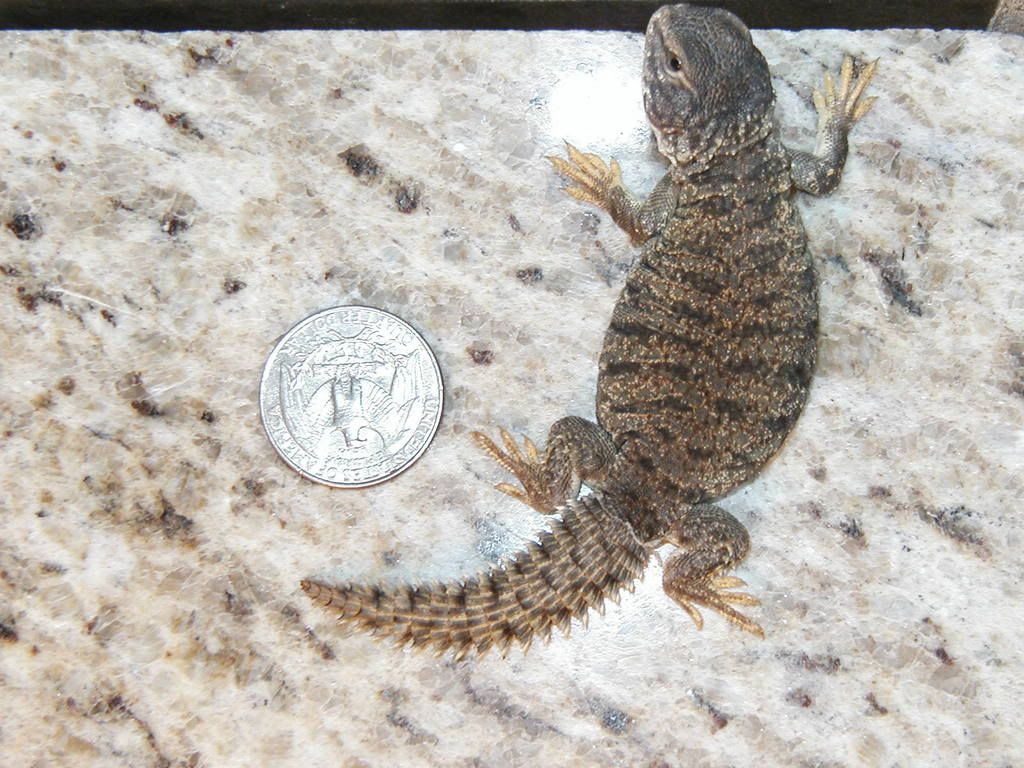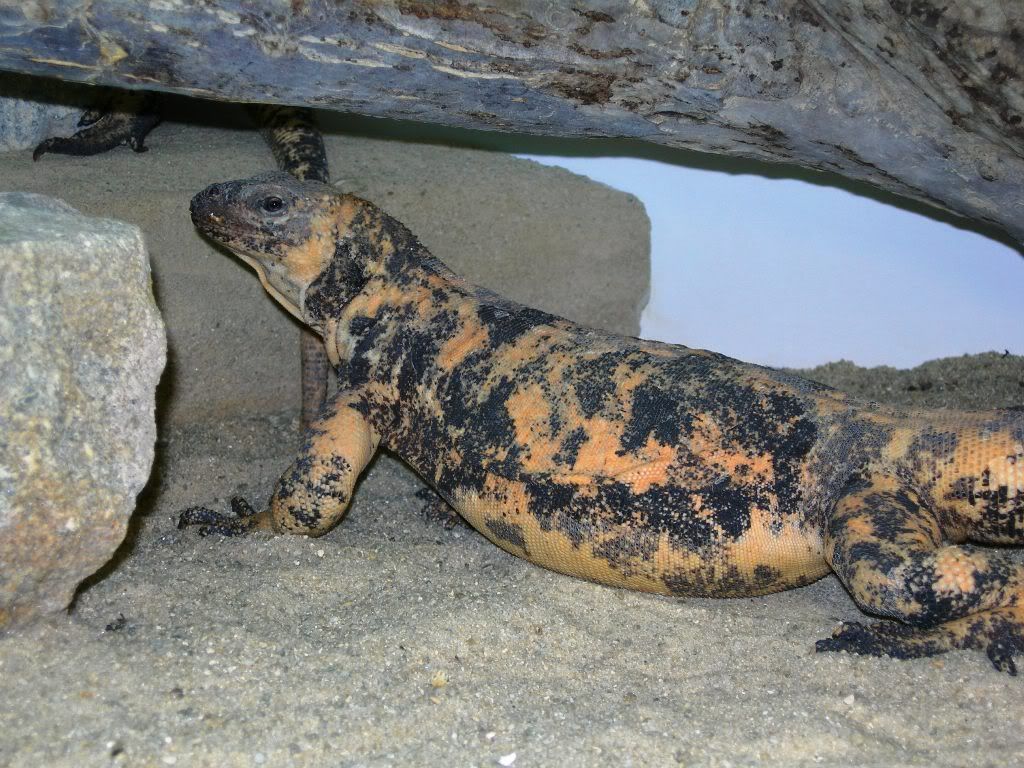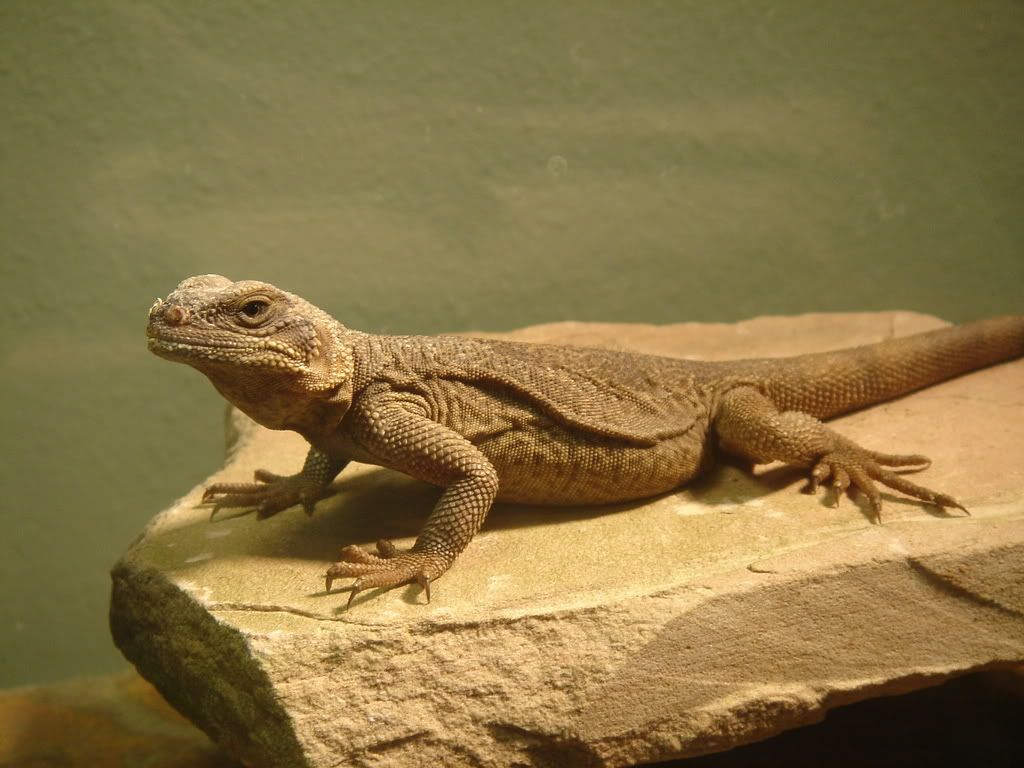|
|
Post by hittorihanzo on Apr 8, 2007 16:35:19 GMT -6
Anyone know where I can get chuckwallas in Tx, I'm looking for Sauromalus Varius (piebald) and Sauromalus Hispidus (Angel Island). Thanks for any help,
HH
|
|
|
|
Post by LadyViper on Apr 8, 2007 20:55:07 GMT -6
I have to admit..I had to look those up, I don't have any leads..but, interesting lizards they are. **************************************************** www.desertusa.com/sept96/du_chuckwalla.htmlChuckwallas GENUS Sauromalus Range Mojave and Sonoran deserts of southeastern California, southern Nevada and Utah, western Arizona and south to Sonora, Mexico and the mainland and islands of Baja. Habitat Open flats and rocky areas, often near large rocks and boulders. Description There is only one species of chuckwalla that inhabits the Southwestern Deserts: the Common Chuckwalla (Sauromalus ater). The San Esteban Island (or Piebald) Chuckwalla (Sauromalus varius), the largest of all the chuckwallas, inhabits only San Esteban Island and Isla Roca Lobos in the Sea of Cortez (Gulf of California). The Piebald Chuckwalla, has a gray-to-black face, with same-colored splotches over its entire body, which is tan to yellow. There is now and has been a study going on for years at the Arizona Sonora Desert Museum involving San Esteban Island Chuckwallas, where there is a large breeding colony. Among other things, the behavior and reproductive biology of these impressive lizards is being studied there. There is another Baja Island form which is quite distinctive, Sauromalus hispidus, the Spiny Chuckwalla. This species lives on Isla Angel de la Guarda and several smaller islands near Bahía de Los Angeles. What makes this animal very different is its spiny tail. All other Chuckwallas have a much smoother tail. Sauromalus ater is the name presently given to all Chuckwallas living in our Southwestern Deserts. All of the former subspecies of S. obesus are now included in the single species, S. ater. These large, plump lizards have loose folds of skin around the neck and shoulders. They have a thick blunt tail and grow 11 to 18 inches long. These diurnal lizards emerge in the morning and, before seeking food, bask in the sun until its optimum body temperature of 100 - 105 degrees F. is reached. Strictly herbivorous, it eats fruit, leaves, buds and flowers. When the Chuckwalla senses danger, it scurries between rocks and lodges itself tightly in crevices by inflating itself.In the Common Chuckwalla, depending upon the population, male coloration may include black head, forelegs and upper trunk, and reddish-yellow toward the rear or a showy bright red body. Females are usually a much less showy gray or brown with little pattern. The young, however, are usually quite striking with a dark background color and yellow bands around the body and down onto the tail." |
|
|
|
Post by LizardKing on Apr 8, 2007 21:05:08 GMT -6
Very cool lizard, but I hadnt heard of them before untill this so I have no idea. They are cool looking though.
|
|
|
|
Post by hittorihanzo on Apr 9, 2007 8:23:22 GMT -6
I've had Uro's for years now and I'm at a point where I have enough time to keep something that can be handled alot. I'm sure that I can get them from a place in Vegas but would rather get them locally for obvious reasons. S. Varius are awesome, they almost have the same pattern as a coy (coi), they get to about 2 feet, and become very tame almost to the point of being dependant on human contact, thanks for the replies, if anyone has alot of herp connections and can casually pursue finding some that'd be cool, can we post pics on this site?
HH
|
|
|
|
Post by LadyViper on Apr 9, 2007 9:23:51 GMT -6
You can post pics, please do.. Viper has a post under the section..ask the Moderators.. for instructions on how too.
|
|
|
|
Post by LadyViper on Apr 9, 2007 9:28:38 GMT -6
Is a Uromastyx and a Chuckwallas the same thing?
|
|
|
|
Post by hittorihanzo on Apr 9, 2007 11:13:37 GMT -6
Umm...Uro's are native to North Africa and have much more stringent husbandry requirements, in room temperature their body temp falls so fast they can become inactive within minutes. Chucks are native to the U.S. (second in size only to Gila's) and can be handled at room temp (especially a herp room temp) for much longer. They also have fewer natural predators and are much less skittish. This is my youngest Uro Koopa (U. Maliensis) at about 4-6 mos. 3 years ago  This is a baby S. sispidus (Angel Island Chuckwalla)  and this is an adult S. Varius (San Esteban Island Chuckwalla) which I would pay top dollar to get a pair of hatchling to juvies  Hope my image posting works out or this post will be kinda lame. They are very different and I love Uro's but I really want more of a "lap lizard" for lack of a better term. HH |
|
|
|
Post by hittorihanzo on Apr 9, 2007 11:15:46 GMT -6
BTW I really like y'alls site, I'm surprised there aren't more active posters.
HH
|
|
|
|
Post by hittorihanzo on Apr 9, 2007 11:17:35 GMT -6
The second image should say S. hispidus instead of ispidus......
|
|
|
|
Post by LadyViper on Apr 9, 2007 11:37:37 GMT -6
Thanks. I am surprised it's not more active too, but I think everybody posts on our yahoo group. It's very active. I think the problem with the website is we don't have thread noticification, so people post and forget about us.
|
|
|
|
Post by hittorihanzo on Apr 9, 2007 12:26:39 GMT -6
I just signed up to join the group, I'm not a web design expert, but I imagine e-mail notification of replies to posts shouldn't be that hard to set-up, especially for whoever designed this site, it's really well put together.
HH
|
|
|
|
Post by Viper on Apr 11, 2007 17:43:04 GMT -6
Thanks man!
|
|
|
|
Post by LizardKing on Apr 11, 2007 20:51:03 GMT -6
You have Uros so you must know about beardies!>!>! They are the BEST lap lizard ever! mine never move when I have them on me. I put them on the floor and they are gone, but as far as sitting still on you they sure do that. Incase you dont know anything about them...
Adverage size 18-20 inch female 19-24 inch male
Temperment: very docile, but can be prevoked into a mild anger
Care: You have uros.. pretty much the exact same thing...
|
|
|
|
Post by hittorihanzo on May 3, 2007 14:58:05 GMT -6
Just thought I'd update anyone that checks this forum, I got my Angel Island Chuckwalla (S. hispidus) from Vegas about two weeks ago. I'll post pics from the day he got here, he's put on what seems like a ton of weight in the last two weeks though. He definately won't be my last chuck. His name is Bowser.   One of my good friends has a beardie, but it has a huge attitude. he assured me that most aren't like that. I would like to get one eventually, what different types of color morphs are out there? I generally like to get stuff that is out of the ordinary. How much do baby beardie's go for? HH |
|
|
|
Post by LizardKing on May 5, 2007 7:53:32 GMT -6
There are a ton of different morphs. I personally have a sandfire and a charcoal but there are many more. Depending on the morph they start at 45 and can run several hundered dollars. My sandfire is a $200 morph at its size right now but as a baby would be more like 100 or so. Most beardies are mild temperd as long as you give them attention daily. Its the people who just "Have" them that have the mean ones.
|
|